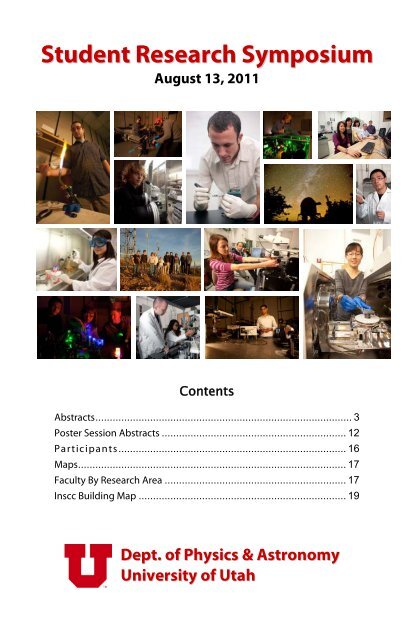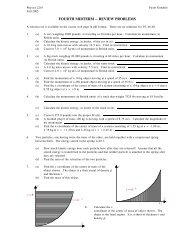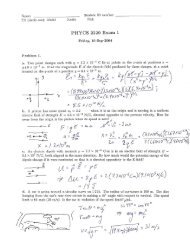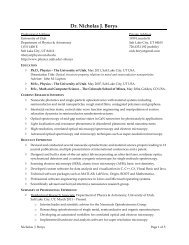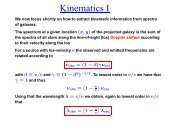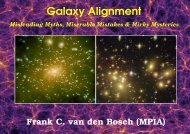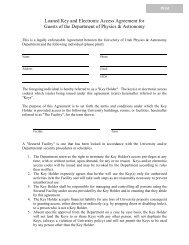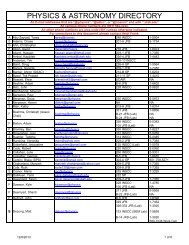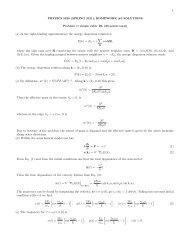Student Research Symposium - Department of Physics & Astronomy ...
Student Research Symposium - Department of Physics & Astronomy ...
Student Research Symposium - Department of Physics & Astronomy ...
You also want an ePaper? Increase the reach of your titles
YUMPU automatically turns print PDFs into web optimized ePapers that Google loves.
<strong>Student</strong> <strong>Research</strong> <strong>Symposium</strong><br />
August 13, 2011<br />
..<br />
.<br />
.<br />
.<br />
.<br />
.<br />
.<br />
.<br />
.<br />
.<br />
.<br />
.<br />
.<br />
Contents<br />
Abstracts ......................................................................................... 3<br />
Poster Session Abstracts ................................................................ 12<br />
Participants............................................................................... 16<br />
Maps............................................................................................. 17<br />
Faculty By <strong>Research</strong> Area ............................................................... 17<br />
Inscc Building Map ........................................................................ 19<br />
Dept. <strong>of</strong> <strong>Physics</strong> & <strong>Astronomy</strong><br />
University <strong>of</strong> Utah
S ESSION 1<br />
S ESSION 2<br />
S ESSION 3<br />
Schedule <strong>of</strong> Presentations<br />
Time Room Title Speaker<br />
8:50-9:00 AM Lobby Welcome<br />
9:00 AM 110 INSCC<br />
9:15 AM 110 INSCC<br />
9:30 AM 110 INSCC<br />
9:45 AM 110 INSCC<br />
10:00 AM 110 INSCC<br />
10:15 AM 110 INSCC<br />
High Angular Resolution Imaging with<br />
Intensity Interferometry Using Air Cherenkov<br />
Telescope Arrays<br />
Long Spin Coherence Lifetimes <strong>of</strong> Optically<br />
Generated Excitations in Colloidal CdS<br />
Nanorods<br />
Room Temperature Charge Carrier Spin<br />
Quantum Phase Coherence in Organic<br />
Semiconductors<br />
Verifying the Presence <strong>of</strong> the Hyperfine<br />
Interaction In LED's<br />
Using A Nanostructure to Redirect<br />
Fluorescence Emission from Individual<br />
Quantum Dots<br />
Collisional 3He & 129Xe Frequency Shifts in<br />
Rb–Noble-Gas Mixtures<br />
9:30-9:45 AM Lobby Break<br />
11:00 AM 110 INSCC Charmonium Spectroscopy in Lattice QCD<br />
11:15 AM 110 INSCC Recent Progress in Levin-Wen Models<br />
11:30 AM 110 INSCC<br />
Particle Dynamics in the Galaxy's<br />
Gravitational Potential<br />
11:45 AM 110 INSCC Superconducting Isotope Effect in Lithium<br />
12:00 PM 110 INSCC<br />
12:15 PM 110 INSCC<br />
12:30 PM 110 INSCC<br />
High Pressure Methods for Observing the<br />
Lithium Melting Line<br />
Live Imaging <strong>of</strong> Escrt Recruitment in Virus<br />
Budding<br />
Vesicular Stomatitis Virus Glycoprotein<br />
Microdomain Organization<br />
1:00-2:00 PM Lobby Lunch<br />
2:00 PM 110 INSCC Dark Matters<br />
2:15 PM 110 INSCC<br />
2:30 PM 110 INSCC<br />
2:45 PM 110 INSCC<br />
3:00 PM 110 INSCC<br />
3:15 PM 110 INSCC<br />
3:30 PM 110 INSCC<br />
Using Chemical Signatures <strong>of</strong> Kinematically<br />
Selected Stars to Trace Galactic Mergers<br />
On the Na-O Anticorellation & Other<br />
Abundances in NGC 1261<br />
A Proposal for a Low Resolution Stellar<br />
Abundance Derivation Technique<br />
Raman Spectroscopy Studies <strong>of</strong> Meteoritic<br />
Structures: Implications for Planet Formation<br />
Summer 2011 VERITAS Observations <strong>of</strong><br />
Nearby Blazar "BL Lac"<br />
Radar Chirps from Extragalactic Cosmic Ray<br />
Air Showers<br />
3:45 -4:30 PM Lobby Poster Session<br />
Paul Nunez<br />
Graduate <strong>Student</strong><br />
Kipp van Schooten<br />
Graduate <strong>Student</strong><br />
Will Baker<br />
Graduate <strong>Student</strong><br />
Thomas Van Hook<br />
Ugraduate <strong>Student</strong><br />
Anil Ghimire<br />
Graduate <strong>Student</strong><br />
Zayd Ma<br />
Graduate <strong>Student</strong><br />
Song-haeng Lee<br />
Graduate <strong>Student</strong><br />
Yuting Hu<br />
Graduate <strong>Student</strong><br />
Benjamin Czaja<br />
Ugraduate <strong>Student</strong><br />
Barun Gupta<br />
Graduate <strong>Student</strong><br />
William Talmadge<br />
Ugraduate <strong>Student</strong><br />
Pei-I Ku<br />
Graduate <strong>Student</strong><br />
Xiaolin Tang<br />
Graduate <strong>Student</strong><br />
Luca Visinelli<br />
Graduate <strong>Student</strong><br />
Dylan Gregersen<br />
Ugraduate <strong>Student</strong><br />
Dan Filler<br />
Ugraduate <strong>Student</strong><br />
Tim Anderton<br />
Ugraduate <strong>Student</strong><br />
Bhuwan Ghimire<br />
Ugraduate <strong>Student</strong><br />
Spencer Hatch<br />
Ugraduate <strong>Student</strong><br />
Jamie Rankin<br />
Ugraduate <strong>Student</strong><br />
2
Abstracts<br />
RESEARCH SYMPOSIUM ABSTRACTS<br />
(arranged by session)<br />
<strong>Department</strong> <strong>of</strong> <strong>Physics</strong> & <strong>Astronomy</strong><br />
High Angular Resolution Imaging With Intensity Interferometry Using<br />
Air Cherenkov Telescope Arrays<br />
Paul Nunez, Graduate <strong>Student</strong>, nunez.paul@gmail.com<br />
Dr. Stephan LeBohec, www.physics.utah.edu/gammaray<br />
9:00 AM<br />
Most stars are still merely detected as point sources at optical frequencies, and not as<br />
extended objects. This has motivated the development <strong>of</strong> several interferometric<br />
techniques in order to observe their structure at high angular resolution. Intensity<br />
interferometry measures the correlation <strong>of</strong> intensity fluctuations between neighboring<br />
detectors, which in turn provides information about the Fourier transform <strong>of</strong> the stellar<br />
object. Planned air Cherenkov telescope arrays will be ideal for the implementation <strong>of</strong><br />
optical intensity interferometry. These arrays will contain nearly 100 telescopes separated<br />
by up to 1km, and will provide means to resolve stellar structures in the sub-milliarcsecond<br />
scale. Current efforts towards sub-milliarcsecond imaging with intensity interferometry will<br />
be discussed.<br />
Long Spin Coherence Lifetimes Of Optically Generated Excitations In<br />
Colloidal CdS Nanorods<br />
Kipp van Schooten, Graduate <strong>Student</strong>, kippvs@physics.utah.edu<br />
Dr. Christoph Boehme/Dr. John Lupton<br />
www.physics.utah.edu/~boehmelab/research.html<br />
9:15: AM<br />
The nature, interactions and dynamics <strong>of</strong> optically excited spin states in quantum dot<br />
systems has recently been intensely investigated due to the wealth <strong>of</strong> materials<br />
information it gives, as well as the exciting potential for spintronic and quantum<br />
information applications. In particular, spin coherence lifetimes (T2 times) long enough to<br />
make quantum correction algorithms feasible and hyperfine coupling to nuclear spins that<br />
allows for spin storage via dynamic nuclear polarization (DNP) processes have been highly<br />
desired. Therefore, the characterization <strong>of</strong> new candidate spin centers is potentially <strong>of</strong><br />
technological significance and is certainly <strong>of</strong> value to materials research. Here, we describe<br />
our recent observation <strong>of</strong> long T2 times (>1.5ms) for optically generated excitations in<br />
colloidal CdS nanorods at 3.5K. These optically generated states possess very long radiative<br />
lifetimes, which results in there being a large population <strong>of</strong> excited states that persists<br />
beyond 100ms after excitation. This, in turn, leaves a spin population that exists on time<br />
scales to which pulsed magnetic resonance schemes are very sensitive. An optically<br />
detected magnetic resonance (ODMR) scheme is then used to manipulate the spin states<br />
which are associated with these optical excitations. Coherent spin manipulation is<br />
demonstrated and this ultimately allows us to measure the system’s true T2 time by<br />
employing a Hahn echo microwave pulse sequence. In addition to gaining the spin<br />
coherence time, we also report on the simultaneous observation <strong>of</strong> a more subtle<br />
interaction between this excited state and its surrounding environment. The presence <strong>of</strong><br />
this interaction is witnessed as a finer structure splitting in the already Zeeman-split energy<br />
levels and is manifested by a modulation <strong>of</strong> the spin echo amplitude. The exact mechanism<br />
involved (hyperfine, nuclear quadrupole, etc.) is still under investigation<br />
3
RESEARCH SYMPOSIUM ABSTRACTS<br />
(arranged by session)<br />
<strong>Department</strong> <strong>of</strong> <strong>Physics</strong> & <strong>Astronomy</strong><br />
Room Temperature Charge Carrier Spin Quantum Phase Coherence In<br />
Organic Semiconductors<br />
Will Baker, Graduate <strong>Student</strong>, bakerwillis@gmail.com<br />
Dr. Christoph Boehme/Dr. John Lupton<br />
www.physics.utah.edu/~boehmelab/research.html<br />
9:30 AM<br />
This work represents the first room temperature spin-phase storage and recovery<br />
experiment done with an organic polymer device (OLED) measured with a novel electron<br />
spin resonance technique, namely pulsed electrically detected magnetic resonance<br />
(pEDMR) which is sensitive to the mutual spin orientation <strong>of</strong> spin pairs. This experiment<br />
has allowed us to not only obtain the true spin-phase coherence times (different from<br />
dephasing or spin-mixing times), but has also enabled us to gain insight into the<br />
equilibrium transport mechanisms. Consequently, the results have given a confirmation <strong>of</strong><br />
the important role the hyperfine interaction plays in the spin relaxation times. Possibly the<br />
most important result from the given work is the surprisingly weak temperature<br />
dependence in intra-molecular hopping within the formed e-h pair which hints to a slow<br />
tunneling transport mechanism instead <strong>of</strong> the widely accepted thermally driven phononassisted<br />
hopping model.<br />
Verifying The Presence Of The Hyperfine Interaction In Led's<br />
Thomas Van Hook, Ugraduate <strong>Student</strong>, strwrs287@comcast.net<br />
Dr. Brian Saam, www.physics.utah.edu/~hpgas<br />
9:45 AM<br />
10:00 AM<br />
We have been investigating a particular effect present in the organic light-emitting diodes<br />
we have constructed. As current passes through the OLED, the amount <strong>of</strong> resistance in the<br />
OLED varies according to the strength <strong>of</strong> the magnetic field acting upon the device. The<br />
most likely explanation for this effect is the manifestation <strong>of</strong> the hyperfine interaction. If<br />
the HFI is the cause, we can also change the current by manipulating the 1H spins in the<br />
organic substrate through the use <strong>of</strong> NMR techniques. Current data is preliminary but<br />
progressing towards the end goal <strong>of</strong> determining whether or not the hyperfine interaction<br />
creates this effect we see. If indeed the hyperfine interaction is present in this device, the<br />
design could be further adapted to create spintronic devices.<br />
Using A Nanostructure To Redirect Fluorescence Emission From<br />
Individual Quantum Dots<br />
Anil Ghimire, Graduate <strong>Student</strong>, anghimire@hotmail.com<br />
Dr. Jordan Gerton, www.physics.utah.edu/~gertonlab<br />
We studied the angular emission pattern from individual quantum dots in the presence <strong>of</strong><br />
sharp atomic force microscope tips. In particular, we used a unique data acquisition<br />
system to measure changes in the polarization state <strong>of</strong> the emitted light as the distance<br />
between a tip and quantum dot was varied with nanometer-scale precision. The<br />
reorientation <strong>of</strong> the polarization reflects changes in the directionality <strong>of</strong> the emitted light.<br />
Several possible mechanisms for the redirection <strong>of</strong> emission will be discussed.<br />
4
RESEARCH SYMPOSIUM ABSTRACTS<br />
(arranged by session)<br />
<strong>Department</strong> <strong>of</strong> <strong>Physics</strong> & <strong>Astronomy</strong><br />
Collisional 3He And 129Xe Frequency Shifts In Rb–Noble-Gas Mixtures<br />
Zayd Ma, Graduate <strong>Student</strong>, zaydma@physics.utah.edu<br />
Dr. Brian Saam, www.physics.utah.edu/~hpgas<br />
10:15 AM<br />
This talk will explain the physics and results <strong>of</strong> our groups most recent PRL "Collisional 3He<br />
and 129Xe Frequency Shifts in Rb–Noble-Gas Mixtures ". The Fermi-contact interaction that<br />
characterizes collisional spin exchange <strong>of</strong> a noble gas with an alkali-metal vapor also gives<br />
rise to NMR and EPR frequency shifts <strong>of</strong> the noble-gas nucleus and the alkali-metal atom,<br />
respectively. We have measured the enhancement factor κ0 that characterizes these shifts<br />
for Rb-129Xe to be 493±31, making use <strong>of</strong> the previously measured value <strong>of</strong> κ0 for Rb-3He.<br />
This result allows accurate 129Xe polarimetry with no need to reference a thermalequilibrium<br />
NMR signal.<br />
Charmonium Spectroscopy In Lattice QCD<br />
Song-haeng Lee, Graduate <strong>Student</strong>, song@physics.utah.edu<br />
Dr. Carleton Detar, www.physics.utah.edu/~detar<br />
11:00 AM<br />
11:15 AM<br />
Charmonium, discovered in 1974 at Brookhaven and SLAC, is a bound state <strong>of</strong> a charm<br />
quark and anti-charm quark. It provides one <strong>of</strong> the most useful tests <strong>of</strong> the theory <strong>of</strong> strong<br />
forces. In analogy to the bound state e+e- called positronium in which photons mediate<br />
the electromagnetic force (Quantum Electrodynamics), in charmonium, gluons mediate<br />
the strong force between the quark and anti quark (Quantum Chromodynamics). The key<br />
difference between them is the properties <strong>of</strong> the positronium states can be theoretically<br />
determined by traditional methods, whereas, charmonium states cannot. However recent<br />
advances in high-precision numerical computer simulation make the problem solvable<br />
(Lattice Quantum Chromodynamics). That is, now, we can evaluate the spectrum <strong>of</strong><br />
charmonium and match it with the experimental values. Moreover, it is possible to guide<br />
the discovery <strong>of</strong> new states. In this presentation, I talk about the basics <strong>of</strong> LQCD briefly and<br />
the current process <strong>of</strong> the charmonium project.<br />
Recent Progress In Levin-Wen Models<br />
Yuting Hu, Graduate <strong>Student</strong>, yuting.phys@gmail.com<br />
Dr. Carleton Detar, www.physics.utah.edu/~detar<br />
In recent years, two-dimensional topological phases have received growing attention in<br />
condensed matter physics and topological quantum computation. Exactly soluble lattice<br />
models that describe doubled topological phases were proposed by Kitaev, and Levin and<br />
Wen respectively. Here I present a summary <strong>of</strong> the following progress in these models: the<br />
ground state degeneracy, and the fractional statistics <strong>of</strong> flux-type quasiparticles.<br />
5
RESEARCH SYMPOSIUM ABSTRACTS<br />
(arranged by session)<br />
<strong>Department</strong> <strong>of</strong> <strong>Physics</strong> & <strong>Astronomy</strong><br />
Particle Dynamics In The Galaxy's Gravitational Potential<br />
Benjamin Czaja, Ugraduate <strong>Student</strong>, b.czaja@utah.edu<br />
Dr. Ben Bromley, www.physics.utah.edu/~bromley<br />
11:30 AM<br />
The purpose <strong>of</strong> this project is to study the effects that our Galaxy’s gravitational potential<br />
has on photons from the Cosmic Microwave Background (CMB). The CMB is a bath <strong>of</strong><br />
photons that are relics <strong>of</strong> the Universe at early times following the big bang. Photons in<br />
the bath propagate freely in space, but can be deflected from their original paths by the<br />
gravitational potential <strong>of</strong> our Galaxy, the Milky Way. To study this deflection <strong>of</strong> light I<br />
numerically simulated the path <strong>of</strong> light rays as they travel through a three-component<br />
model <strong>of</strong> the Galaxy, with a disk, a central bulge, and an extended halo. Specifically, I<br />
traced light rays deflected by the Galaxy’s gravity according to General Relativity, as they<br />
travel from an observer located at a position near the Sun. The results show that the<br />
amount <strong>of</strong> deflection increases as the light rays travel closer to the center <strong>of</strong> the galaxy;<br />
having a maximum deflection angle <strong>of</strong> 0.812037 arc seconds when traveling through a<br />
region 161.99 arc minutes away from the galactic center. The significance <strong>of</strong> this work is<br />
the prediction <strong>of</strong> a potentially measurable distortion the CMB by the galaxy. In principle<br />
we may use these distortion to map out the gravitational potential <strong>of</strong> the galaxy.<br />
Superconducting Isotope Effect In Lithium<br />
Barun Gupta, Graduate <strong>Student</strong>, barungupta05@gmail.com<br />
Dr. Shanti Deemyad, www.physics.utah.edu/~deemyad<br />
11:45 AM<br />
Lithium is the lightest elemental superconductor. While the superconducting transition<br />
temperature Tc <strong>of</strong> lithium is very low at ambient pressure, Tc reaches 20K under pressure.<br />
Due to its light mass, ionic quantum motion may have a substantial contribution to the<br />
lattice dynamics <strong>of</strong> lithium, and the isotope effect in superconducting lithium may reveal<br />
interesting physics. While the superconducting phase diagram <strong>of</strong> Li7 under pressure is<br />
well studied, the superconductivity <strong>of</strong> Li6 has not been studied experimentally. In this talk,<br />
I will present our experimental approach in studying the superconducting isotope effect in<br />
pressurized lithium and discuss possible interesting outcomes <strong>of</strong> this study.<br />
6
RESEARCH SYMPOSIUM ABSTRACTS<br />
(arranged by session)<br />
<strong>Department</strong> <strong>of</strong> <strong>Physics</strong> & <strong>Astronomy</strong><br />
High Pressure Methods For Observing The Lithium Melting Line<br />
William Talmadge, Ugraduate <strong>Student</strong>, willtalmadge@gmail.com<br />
Dr. Shanti Deemyad, www.physics.utah.edu/~deemyad<br />
12:00 PM<br />
Theoretical work has suggested that lithium has the unusual property that its melting<br />
point decreases rather dramatically as pressure is increased from 12 GPa to 40 GPa. In fact<br />
the melting temperature is predicted to reach a minimum as low as 200 K. This has<br />
suggested the possibility <strong>of</strong> the formation <strong>of</strong> a quantum fluid. Some experimental work<br />
provides evidence <strong>of</strong> this cold melting in lithium. However, the entire phase diagram from<br />
15 GPa to 100 GPa, and beyond is not well observed. We present experimental apparatus<br />
and methods that allow direct observation <strong>of</strong> this melting line at high pressure. We<br />
generate the extreme pressures needed by placing the sample within a diamond anvil cell.<br />
When high temperatures are needed for melting we use an infrared laser to melt the<br />
sample and measure these temperatures with a high sensitivity pyrometer. The melting<br />
point is observed and confirmed with two methods. We can observe a laser speckle pattern<br />
in situ to observe physical changes in the surface <strong>of</strong> the material caused by melting.<br />
Additionally we can finely control how much a sample is heated and observe the<br />
temperature plateau that results from the enthalpy <strong>of</strong> fusion <strong>of</strong> lithium. If the melting line<br />
decreases below room temperature we will use a conventional cryostat to follow the meltline.<br />
Live Imaging Of Escrt Recruitment In Virus Budding<br />
Pei-I Ku, Graduate <strong>Student</strong>, peii39@gmail.com<br />
Dr. Saveez Saffarian, www.physics.utah.edu/~saffarian<br />
12:15 PM<br />
While recent years have seen rather dramatic advances in our understanding <strong>of</strong> how<br />
enveloped viruses achieve separation from their cellular hosts, several pressing questions<br />
remain. One central question is the precise role <strong>of</strong> ESCRT (Endosomal Sorting Complexes<br />
Required for Transport) proteins, which normally play an essential role in fundamental<br />
intracellular pathways, in virus release. Additional problems are assigning specific roles in<br />
viral processing to Alix (a cellular Class E protein that interacts directly with the ESCRT<br />
machinery to facilitate viral assembly and release) and, in the case <strong>of</strong> HIV, to the L-domains<br />
<strong>of</strong> Gag (responsible for recruiting cellular factors that facilitate budding for HIV-1). Several<br />
plausible hypotheses have been proposed based on studies <strong>of</strong> multivesicular bodies<br />
(MVBs) and in vitro experiments. In order to observe the viral budding process in vivo in<br />
cell membranes and to elucidate the interactions and functions <strong>of</strong> Gag-Alix-ESCRT, we<br />
have employed total internal reflection florescence microscopy (TIRF-M) to analyze<br />
assembly and budding in live cells and to quantitatively examine the interactions <strong>of</strong> Gag-<br />
Alix-ESCRT, from initiation <strong>of</strong> assembly to budding and release. I am currently focusing on<br />
how Alix is recruited to the cell membrane and on its interactions with Gag.<br />
7
RESEARCH SYMPOSIUM ABSTRACTS<br />
(arranged by session)<br />
<strong>Department</strong> <strong>of</strong> <strong>Physics</strong> & <strong>Astronomy</strong><br />
Vesicular Stomatitis Virus Glycoprotein Microdomain Organization<br />
Xiaolin Tang, Graduate <strong>Student</strong>, ttxiaolin@gmail.com<br />
Dr. Saveez Saffarian, www.physics.utah.edu/~saffarian<br />
12:30 PM<br />
2:00 PM<br />
Virus budding continues to be a critical area <strong>of</strong> study in virology. Important questions<br />
include where, when, and how this process occurs and what ensures that it proceeds<br />
smoothly. We are particularly interested in the initiation <strong>of</strong> virus budding, specifically<br />
whether the budding site is specifically directed or whether it is simply a random choice,<br />
and what initiates this process. In the case <strong>of</strong> vesicular stomatitis virus (VSV) the actions <strong>of</strong><br />
its glycoprotein (VSVG), its only transmembrane protein, have been thought to be essential<br />
to the above questions. Most membrane proteins, including viral envelope glycoproteins,<br />
are considered to be organized into locally concentrated areas referred to as membrane<br />
microdomains. These microdomains are thought to be the sites <strong>of</strong> virus budding and even<br />
the entry sites for virus. In previous studies, Lyles and Brown used a novel method in<br />
conjunction with thin-section immuno-gold EM to determine that VSVG is organized into<br />
microdomains on the plasma membrane and that the microdomains eventually form virus<br />
budding sites. However, these microdomain data have not yet been confirmed in<br />
experiments with live cells. Fluorescence correlation spectroscopy (FCS) is a powerful tool<br />
that can detect fluctuations such as diffusion without disturbing a system, which makes it<br />
especially useful in live cell experiments. We are using this tool to investigate how VSVG<br />
protein is organized on the plasma membrane during transfection and infection, and we<br />
aim to calculate the microdomain size if it indeed exists. In addition, we have the capability<br />
to observe the organization <strong>of</strong> two different VSV proteins simultaneously—e.g., G and M, G<br />
and N, and even G and the VSV ribonucleic protein complex (RNP) —by labeling with two<br />
differently colored fluorescent proteins and thus study interactions between these<br />
proteins. This will allow us to address multiple questions, such as whether or not G protein<br />
is involved in assembly <strong>of</strong> the internal virion components in budding, and whether the<br />
interaction between them can initialize the assembly process. The answers to these<br />
questions will help us to construct a better model <strong>of</strong> virus budding.<br />
Dark Matters<br />
Luca Visinelli, Graduate <strong>Student</strong>, luca.visinelli@gmail.com<br />
Dr. Paolo Gondolo, www.physics.utah.edu/index.php/people/faculty/1096-gondolo<br />
We will explore the reasons why Cold Dark Matter is needed to explain the evolution <strong>of</strong> the<br />
universe. We will also briefly discuss the role <strong>of</strong> dark energy in the modern universe.<br />
8
RESEARCH SYMPOSIUM ABSTRACTS<br />
(arranged by session)<br />
<strong>Department</strong> <strong>of</strong> <strong>Physics</strong> & <strong>Astronomy</strong><br />
Using Chemical Signatures Of Kinematically Selected Stars To Trace<br />
Galactic Mergers<br />
Dylan Gregersen, Ugraduate <strong>Student</strong>, dylan.gregersen@utah.edu<br />
Dr. Inese Ivans, www.cosmic-origins.org<br />
2:15 PM<br />
Orbital characteristics and chemical signatures <strong>of</strong> stars are used as indicators <strong>of</strong> their<br />
origins. Recent work by Allen et al. (2007) utilized catalog information <strong>of</strong> Milky Way halo<br />
stars, classifying these stars into moving clusters based on similarities in orbital energy,<br />
angular momentum, and metal content. My study has recently focused on deriving<br />
chemical signatures <strong>of</strong> one candidate moving cluster which contains the wide binary star<br />
pair HD 134439/134440. By employing high-resolution spectroscopy, chemical<br />
abundances <strong>of</strong> all six stars in this select moving cluster are derived. Particular attention has<br />
been given to α-elements (Mg, Ca, Si, and Ti), which trace star formation history. Low<br />
enhancements <strong>of</strong> α-elements are <strong>of</strong>ten used to determine extragalactic origins. Initial<br />
results from stars <strong>of</strong> this moving cluster reveals α enhancements <strong>of</strong> [α/Fe] ~ 0.1 – 0.3 dex,<br />
which is lower than the enhancements common to halo stars <strong>of</strong> galactic origins ([ α/Fe] ~<br />
0.5). This discovery supports Allen et al.'s claim that these stars are associated with a<br />
discrete accretion event, such as the dissolution <strong>of</strong> a globular cluster or the merger <strong>of</strong> a<br />
dwarf spheroidal galaxy into the Milky Way.<br />
On The Na-O Anticorellation And Other Abundances In NGC 1261<br />
Dan Filler, Ugraduate <strong>Student</strong>, danfiller1@gmail.com<br />
Dr. Inese Ivans, www.cosmic-origins.org<br />
2:30 PM<br />
The evolution <strong>of</strong> globular clusters is not fully understood. However, by using chemical<br />
abundances <strong>of</strong> stars we see today, astronomers are able to decipher what conditions may<br />
have existed in the early Galaxy, and model the evolution <strong>of</strong> globular clusters. We present<br />
the first spectroscopic analysis <strong>of</strong> the galactic cluster NGC 1261. Multi-line equivalent<br />
width analysis, spectrum synthesis and model stellar atmospheres were employed to<br />
derive elemental abundances for three stars in NGC 1261. The overall metallicity, [Fe/H] = -<br />
1.10 +/- 0.02, is within expectations based upon photometric estimates. However, the Na-<br />
O anti-correlation, spanning over 1.2 dex in sodium, is larger than any other cluster. This<br />
anti-correlation is possibly from an earlier generation <strong>of</strong> stars in the cluster that may have<br />
polluted the atmospheres <strong>of</strong> the current generation, or maybe polluted material from<br />
which they were born. In addition to the neutron capture element EU, (which is created<br />
from core collapse supernovae), abundances <strong>of</strong> the alpha elements (Mg, Ca, Si, and TI),<br />
created by both core collapses and thermonuclear SNE, iron peak elements (V, Cr, MN, Co<br />
and Ni) and the light elements (C, N and O), which also trace stellar nuclear synthesis, are<br />
reported.<br />
9
RESEARCH SYMPOSIUM ABSTRACTS<br />
(arranged by session)<br />
<strong>Department</strong> <strong>of</strong> <strong>Physics</strong> & <strong>Astronomy</strong><br />
A Proposal For A Low Resolution Stellar Abundance Derivation<br />
Technique<br />
Tim Anderton, Ugraduate <strong>Student</strong>, quidditymaster@gmail.com<br />
Dr. Inese Ivans, www.cosmic-origins.org<br />
2:45 PM<br />
Elemental abundances can be a powerful tool in tracing stellar evolution and<br />
differentiating stellar populations with different origins. The method <strong>of</strong> individual line<br />
analysis in high resolution spectroscopy allows excellent abundances <strong>of</strong> many elements to<br />
be derived for stars with high a resolution and high signal to noise spectrum available. But<br />
this technique becomes difficult or impossible as the data become progressively more<br />
noisy or lower in resolution. The ready availability <strong>of</strong> large numbers <strong>of</strong> low resolution<br />
spectra from surveys such as SDSS has spurred a number <strong>of</strong> methods for the determination<br />
<strong>of</strong> iron abundances from such data. However, there is a dearth <strong>of</strong> techniques to use such<br />
data to find the abundances <strong>of</strong> other specific elements, e.g. manganese, chromium,<br />
titanium. I propose a new abundance derivation technique for use on low resolution data<br />
which decomposes an observed spectrum into a continuum part and a set <strong>of</strong> deformations<br />
which are associated with the absorption spectrum <strong>of</strong> elements at different abundance<br />
levels. This decomposition can then be used to estimate stellar abundances. Preliminary<br />
results will be shared.<br />
Raman Spectroscopy Studies Of Meteoritic Structures: Implications For<br />
Planet Formation<br />
Bhuwan Ghimire, Ugraduate <strong>Student</strong>, BGhimire.12@westminster-mo.edu<br />
Dr. Gerton, Dr. Ivans, Dr. Bromley, www.physics.utah.edu/~gertonlab<br />
3:00 PM<br />
A hierarchical model for the early stages <strong>of</strong> planet formation involves the coagulation <strong>of</strong><br />
micron-scale dust particles orbiting the sun into larger, centimeter- or meter-scale objects.<br />
Computational simulations can produce planetary distributions that agree with<br />
astronomical data when they start with planetesimals <strong>of</strong> 1 km or more in size. However, it is<br />
unclear to date how these planetesimals arose from the dust. One possibility is that the<br />
dust’s small-scale structure enhanced adhesion and coagulation. At very least, this<br />
structure, as preserved in stony meteorites, may provide clues to the physical processes<br />
during this critical juncture in planet formation. It is unclear <strong>of</strong> the adhesion property <strong>of</strong> the<br />
dust aggregates ultimately leading to the formation <strong>of</strong> structures like planetesimals. Other<br />
compounds including minerals might also have accumulated on the dust particles.<br />
Confocal Raman microscopy was used to investigate the microstructures on meteorites.<br />
They are composed <strong>of</strong> chondrules which were rich in our samples and inclusions which are<br />
both embedded in the matrix material. Raman scattering produces an optical spectrum,<br />
which when compared to reference spectra can yield information on the specific chemical<br />
compounds present in and around the matrix <strong>of</strong> meteorites. To date, it has been possible<br />
to distinguish the chondrules composed mainly <strong>of</strong> minerals like Olivine and Pyroxene, from<br />
the matrix <strong>of</strong> pre-solar grains. Raman mapping <strong>of</strong> meteorite samples is pursued, with a<br />
focus on the interfaces between chondrules and the matrix.<br />
10
RESEARCH SYMPOSIUM ABSTRACTS<br />
(arranged by session)<br />
<strong>Department</strong> <strong>of</strong> <strong>Physics</strong> & <strong>Astronomy</strong><br />
Summer 2011 VERITAS Observations Of Nearby Blazar "BL Lac"<br />
Spencer Hatch, Ugraduate <strong>Student</strong>, spencerhatch@weber.edu<br />
Dr. Dave Kieda, www.physics.utah.edu/gammaray<br />
3:15 PM<br />
BL Lacertae (BL Lac) is a nearby (z ~ .0688) active galaxy with strong optical polarization<br />
and variability, as well as a non-thermal emission spectrum. It is also the prototype <strong>of</strong> a<br />
whole class <strong>of</strong> blazars known as ?BL Lac objects? which share similar polarization and<br />
variability properties. Some objects belonging to this class have been identified as veryhigh<br />
energy (VHE) emitters (E > 0.1TeV), while BL Lac has remained an unconfirmed source<br />
<strong>of</strong> VHE gamma-ray emission until recently. In late May 2011, the Fermi Large Area<br />
Telescope (LAT) reported observing BL Lac in a high gamma-ray state, which led to a brief<br />
multi-wavelength campaign involving several institutions, including the Very Energetic<br />
Radiation Imaging Telescope Array System (VERITAS) in southern Arizona. VERITAS<br />
observed BL Lac for a total <strong>of</strong> nine hours over the course <strong>of</strong> several weeks, extending from<br />
late May to early July. Standard analysis has yielded little evidence for gamma-ray emission<br />
from BL Lac, with the very notable exception <strong>of</strong> a gamma-ray outburst on the evening <strong>of</strong><br />
June 28th. In this talk, I'll discuss the recent observations <strong>of</strong> BL Lac by VERITAS, as well as<br />
potential constraints they may place on the origin <strong>of</strong> gamma-ray emission in BL Lac.<br />
Radar Chirps From Extragalactic Cosmic Ray Air Showers<br />
Jamie Rankin, Ugraduate <strong>Student</strong>, jamie.rankin@utah.edu<br />
Telescope Array. www.telescopearray.org<br />
3:30 PM<br />
Ultra-High Energy Cosmic Rays (UHECRs) are cosmic rays with energies <strong>of</strong> 1018 eV and<br />
higher. Comprised <strong>of</strong> the highest energy particles in the universe – many orders or<br />
magnitude higher than man-made accelerator particles – one cannot help but wonder,<br />
what astronomical objects can accelerate particles to this energy? No one knows. As a<br />
result, by looking for anisotropy, collecting events, and studying UHECRs, large cosmic ray<br />
experiments are trying to solve for clues as to what the sources might be. However, due to<br />
the high cost in materials and physical space currently required to detect UHECRs, it is<br />
unlikely that larger experiments can be built. Thus, we are currently exploring an<br />
alternative method <strong>of</strong> detecting UHECR air showers by bouncing radio signals <strong>of</strong>f <strong>of</strong> them.<br />
In doing this, a transmitted signal hits an incoming air shower and the signal is reflected to<br />
a receiver which, in turn, sees a time-dependent phase change equivalent to a frequency<br />
shift. The resulting radio reflection with the frequency changing over time in this way is<br />
called a chirp. This summer, I have been developing a program to simulate chirps at<br />
varying geometries in order to investigate regularities in the signals with the goal <strong>of</strong><br />
eventually reconstructing air showers from these radio reflections.<br />
11
POSTER SESSION ABSTRACTS<br />
<strong>Department</strong> <strong>of</strong> <strong>Physics</strong> & <strong>Astronomy</strong><br />
Spin-Dependent Processes In Amorphous Silicon-Rich Silicon-Nitride<br />
Sang-Yun Lee, Graduate <strong>Student</strong>, beryl236@gmail.com<br />
Dr. Christoph Boehme, www.physics.utah.edu/~boehmelab/research.html<br />
POSTER<br />
Non-stoichiometric silicon-rich silicon-nitride(SiNx) has recently attracted attention as<br />
material for tunable LEDs as well as for photoelectrochemical (PEC) hydrogen production<br />
due to its electronic properties and its excellent resistance to corrosion. For any <strong>of</strong> these<br />
applications, the understanding <strong>of</strong> charge transport and recombination are important as<br />
both play an important role for optoelectronic properties <strong>of</strong> SiNx. Transport and<br />
recombination in disordered silicon materials are strongly influenced by a variety <strong>of</strong><br />
localized, paramagnetic defect states and electron spin resonance (ESR) spectroscopy can<br />
therefore be used to investigate how these states, influence charge transport and<br />
recombination. We present here pulsed electrically detected magnetic resonance<br />
experiments which are measurements <strong>of</strong> pulsed ESR induced changes <strong>of</strong> spin-dependent<br />
photocurrents in SiNx p-i-n stacks at T=15 K. The measurements exhibit spin-Rabi<br />
oscillations which allow a mapping <strong>of</strong> the observed spin-dependent signals as functions <strong>of</strong><br />
the Landé g-factors and different spin-coupling regimes <strong>of</strong> the involved spins. By these<br />
means we observe the influence <strong>of</strong> dangling bond- and band tail-states as well as<br />
combinations there<strong>of</strong>. These observed spin-dependent currents involve paramagnetic<br />
centers which are mutually uncoupled, dipolar-coupled or exchange-coupled, similar to<br />
amorphous silicon (a-Si). However, unlike for a-Si:H, the transitions between strongly spincoupled<br />
pairs in SiNx significantly influence the conductivity, and are therefore due to nongeminate<br />
recombination processes. This demonstrates that adding a small amount <strong>of</strong><br />
nitrogen atoms enhances the conversion <strong>of</strong> geminate to non–geminate charge carrier<br />
pairs in a-SiNx, indicating that this material when used for PEC electrodes could actually<br />
lead to larger internal quantum efficiencies than pure a-Si:H.<br />
HAWC Observatory<br />
Ahron Barber, Graduate <strong>Student</strong>, ahron.barber@gmail.com<br />
Dr. Dave Kieda, www.physics.utah.edu/gammaray<br />
POSTER<br />
HAWC (High Altitude Water Cherenkov Observatory) is a new all-sky TEV gamma ray<br />
observatory being built on Sierra Negra, Mexico at an altitude <strong>of</strong> 4100 m. The all sky<br />
coverage and high duty cycle will give HAWC approximately an order <strong>of</strong> magnitude<br />
greater sensitivity than its predecessor, Milagro. The primary focus <strong>of</strong> HAWC is to study<br />
Gamma Ray Bursts, galactic and extragalactic gamma ray sources, along with the large<br />
scale cosmic ray anisotropy first observed by Milagro and ARGO. HAWC will also be used<br />
for ground level solar physics.<br />
12
POSTER SESSION ABSTRACTS<br />
<strong>Department</strong> <strong>of</strong> <strong>Physics</strong> & <strong>Astronomy</strong><br />
Benchmarking SDSS-Segue Estimated Stellar Parameters Using High<br />
Resolution Spectra Of SDSS Stars<br />
Iranga Samarasingha, Ugraduate <strong>Student</strong>, u0664549@utah.edu<br />
Dr. Inese Ivans, www.cosmic-origins.org<br />
POSTER<br />
We have analyzed the high-resolution spectra <strong>of</strong> 250 stars to estimate the stellar<br />
parameters <strong>of</strong> the previously obtained low resolution data taken for the Sloan Extension<br />
for Galactic Understanding and Exploration (SEGUE). SEGUE has gathered low-resolution<br />
spectra covering the entire optical range <strong>of</strong> 240,000 stars in the Milky Way. SEGUE was<br />
designed as one <strong>of</strong> the main projects <strong>of</strong> the Sloan Digital Sky Survey (SDSS) to explore the<br />
chemical enrichment history <strong>of</strong> our galaxy. SDSS, the largest astronomical survey in the<br />
history <strong>of</strong> humanity explores the universe by gathering images and spectra <strong>of</strong> millions <strong>of</strong><br />
objects in the sky. Studying the high resolution spectroscopic data gathered using the<br />
following observatories and instruments (Keck: HIRES & ESI, Subaru: HDS, HET:HRS, and<br />
VLT:UVES), we compute the stellar surface gravity measurements (the gravitational<br />
acceleration at the surface <strong>of</strong> a star) to compare with the results <strong>of</strong> SEGUE Stellar Parameter<br />
Pipeline. I have also derived the radial velocities and confirmed important stellar<br />
atmospheric parameters such as effective temperature and metallicity. The comparison <strong>of</strong><br />
the resulting surface gravity measurements between the high resolution an low resolution<br />
data will provide an insight into the accuracy <strong>of</strong> the methods used to derive the stellar<br />
atmospheric parameters from the SEGUE spectroscopic observations. These results can be<br />
applied to the significantly more distant stars, too dim to be observed via high-resolution<br />
spectroscopy.<br />
Crystal Orientation Induced Spin Rabi Beat Oscillations Of Point<br />
Defects At The c-Si(111)/SiO2 Interface<br />
Seoyoung Paik, Graduate <strong>Student</strong>, seoyoung.paik@gmail.com<br />
Dr. Christoph Boehme, www.physics.utah.edu/~boehmelab/research.html<br />
POSTER<br />
Spin-dependent electronic transitions such as certain charge carrier recombination and<br />
transport processes in semiconductors are usually governed by the Pauli blockade within<br />
pairs <strong>of</strong> two paramagnetic centers. One implication <strong>of</strong> this is that the manipulation <strong>of</strong> spin<br />
states, e.g. by magnetic resonant excitation, can produce changes to electric currents <strong>of</strong><br />
the given semiconductor material. If both spins are changed at the same time, quantum<br />
beat effects such as beat oscillation between resonantly induced spin Rabi nutation<br />
becomes detectable through current measurements [1]. Here, we report on electrically<br />
detected spin Rabi beat oscillation caused by pairs <strong>of</strong> 31P donor states and Pb interface<br />
defects at the phosphorous doped Si(111)/SiO2 interface. Due to the g-factor anisotropy<br />
<strong>of</strong> the Pb center we can tune the intra pair Larmor frequency difference (so called Larmor<br />
separation) through orientation <strong>of</strong> the sample with regard to the external magnetic field.<br />
As the Larmor separation governs the spin Rabi beat oscillation, we show experimentally<br />
how the crystal orientation can influence the beat effect.<br />
13
POSTER SESSION ABSTRACTS<br />
<strong>Department</strong> <strong>of</strong> <strong>Physics</strong> & <strong>Astronomy</strong><br />
Constructing A Super-Resolution Fluorescent Imaging System Using A<br />
Confocal Microscope Built By Undergraduates<br />
Carl Ebeling, Graduate <strong>Student</strong>, carlgebeling@gmail.com<br />
Dr. Jordan Gerton, www.physics.utah.edu/~gertonlab<br />
POSTER<br />
The incorporation <strong>of</strong> fluorescent proteins attached to specific target proteins within cells<br />
using transgenic techniques has made light microscopy a powerful tool in the research <strong>of</strong><br />
biological specimens, allowing for the study <strong>of</strong> protein location in cells. Due to the<br />
diffraction limit, however, fluorescent proteins can only be resolved to a separation <strong>of</strong><br />
approximately λ/2, or ~200-250 nm, in conventional imaging systems. Super-resolution<br />
optical imaging has provided a method to overcome this barrier, beginning with pointspread<br />
function engineering (STED), and now with localization techniques (PALM, FPALM,<br />
BP-FPALM, and DH-PSF). While fluorescent proteins are versatile and powerful cellular<br />
markers, they have low photon-yields, which provides a limitation to localization ability.<br />
Microscopy methods that decrease the photo-bleaching rate <strong>of</strong> fluorescent proteins,<br />
thereby increasing the photon-yield, are key to increasing the localization accuracy <strong>of</strong> such<br />
techniques. We investigate here the use <strong>of</strong> a scanning confocal PALM microscope built by<br />
undergraduate students in an attempt to increase the photon-yield from individual<br />
fluorophores by allowing for fluorophore relaxation between rounds <strong>of</strong> excitation.<br />
Undergraduate students from physics, biochemistry, mathematics, electrical engineering<br />
and computer science worked together over the course <strong>of</strong> a semester to construct a<br />
confocal instrument with an analysis s<strong>of</strong>tware package to perform super-resolution<br />
imaging.<br />
Studies In Asymmetric Properties Of Vesicular Stomatitis Virus (VSV)<br />
Jeff Hodges, Graduate <strong>Student</strong>, physicswannabe@gmail.com<br />
Dr. Saveez Saffarian, www.physics.utah.edu/~saffarian<br />
POSTER<br />
POSTER<br />
Vesicular stomatitis virus (VSV) is an envelope virus similar to rabies with some very<br />
interesting uses in modern science such as drug delivery in oncology. Despite its uses,<br />
many <strong>of</strong> the physical properties <strong>of</strong> the virus have only been studied in vitro on nonfunctioning<br />
viruses; these processes are <strong>of</strong>ten very destructive and lack an in vivo<br />
understanding. My research has focused on the physical properties <strong>of</strong> live VSV samples,<br />
focusing on the asymmetric bullet shape <strong>of</strong> the virus. Using optical microscopy, and atomic<br />
force microscopy I wish to see if the topological shape correlates with asymmetries within<br />
the internal structure <strong>of</strong> the functional virus.<br />
Higher Order Tensor Decomosition<br />
Fangxiang Jiao, Graduate <strong>Student</strong>, fjiao@sci.utah.edu<br />
Dr. Chris Johnson, www.sci.utah.edu<br />
No abstract submitted.<br />
14
POSTER SESSION ABSTRACTS<br />
<strong>Department</strong> <strong>of</strong> <strong>Physics</strong> & <strong>Astronomy</strong><br />
Superconductivity In Low Z Materials<br />
Scott Temple, Ugraduate <strong>Student</strong>, scottrtemple@gmail.com<br />
Dr. Shanti Deemyad, www.physics.utah.edu/~deemyad<br />
POSTER<br />
Our upcoming research project focuses on superconductivity <strong>of</strong> lithium under high<br />
pressure, and the impact <strong>of</strong> isotope effects on the superconducting transition temperature.<br />
Lithium is the lightest superconducting element, and has a significantly higher Tc under<br />
pressure than it does at ambient. We will generate megabar range pressures using a<br />
diamond anvil cell (DAC), and observe the superconducting transition temperature as<br />
pressure changes. We will perform this experiment with both lithium 6 and lithium 7.<br />
Lithium 6 under pressure has not been well studied, and there may be significant variation<br />
because <strong>of</strong> isotope effects. I will focus on the experimental methods we will use in this<br />
study.<br />
15
Participants<br />
Name Email Advisor<br />
Tim Anderton quidditymaster@gmail.com Dr. Inese Ivans<br />
Will Baker bakerwillis@gmail.com Dr. Boehme & Dr. Lupton<br />
Ahron Barber ahron.barber@gmail.com Dr. Dave Kieda<br />
Benjamin Czaja b.czaja@utah.edu Dr. Ben Bromley<br />
Carl Ebeling carlgebeling@gmail.com Dr. Jordan Gerton<br />
Dan Filler danfiller1@gmail.com Dr. Inese Ivans<br />
Anil Ghimire anghimire@hotmail.com Dr. Jordan Gerton<br />
Bhuwan Ghimire<br />
BGhimire.12@westminster-mo.edu<br />
Dr. Bromley, Dr. Gerton, &<br />
Dr. Ivans<br />
Dylan Gregersen dylan.gregersen@utah.edu Dr. Inese Ivans<br />
Barun Gupta barungupta05@gmail.com Dr. Shanti Deemyad<br />
Spencer Hatch spencerhatch@weber.edu Dr. Dave Kieda<br />
Jeff Hodges physicswannabe@gmail.com Dr. Saveez Saffarian<br />
Yuting Hu yuting.phys@gmail.com Dr. Carleton Detar<br />
Fangxiang Jiao fjiao@sci.utah.edu Dr. Chris Johnson<br />
Pei-I Ku peii39@gmail.com Dr. Saveez Saffarian<br />
Sang-Yun Lee beryl236@gmail.com Dr. Christoph Boehme<br />
Song-haeng Lee song@physics.utah.edu Dr. Carleton Detar<br />
Zayd Ma zaydma@physics.utah.edu Dr. Brian Saam<br />
Paul Nunez nunez.paul@gmail.com Dr. Stephan LeBohec<br />
Seoyoung Paik seoyoung.paik@gmail.com Dr. Christoph Boehme<br />
Jamie Rankin jamie.rankin@utah.edu Telescope Array<br />
Iranga Samarasingha u0664549@utah.edu Dr. Inese Ivans<br />
Eric Sorte egsorte@gmail.com Dr. Brian Saam<br />
William Talmadge willtalmadge@gmail.com Dr. Shanti Deemyad<br />
Xiaolin Tang ttxiaolin@gmail.com Dr. Saveez Saffarian<br />
Scott Temple scottrtemple@gmail.com Dr. Shanti Deemyad<br />
Thomas Van Hook strwrs287@comcast.net Dr. Brian Saam<br />
Kipp van Schooten kippvs@physics.utah.edu Dr. Boehme & Dr. Lupton<br />
Luca Visinelli luca.visinelli@gmail.com Dr. Paolo Gondolo<br />
16
Maps<br />
Faculty By <strong>Research</strong> Area<br />
Experimental <strong>Research</strong> Faculty<br />
<strong>Astronomy</strong> & Astrophysics<br />
Adam Bolton 801-585-5383 bolton@physics.utah.edu<br />
Kyle Dawson 801-581-4785 kdawson@physics.utah.edu<br />
Inese Ivans 801-585-5483 iii@physics.utah.edu<br />
David Kieda 801-581-5220 kieda@physics.utah.edu<br />
Stephan LeBohec 801-587-9923 lebohec@physics.utah.edu<br />
Anil Seth<br />
aseth@physics.utah.edu<br />
Atomic <strong>Physics</strong><br />
Brian Saam 801-585-5832 saam@physics.utah.edu<br />
Biophysics<br />
Jordan Gerton 801-585-0068 jgerton@physics.utah.edu<br />
Saveez Saffarian 801-581-5716 saffarian@physics.utah.edu<br />
Michael Vershinin 801-581-5803 vershinin@physics.utah.edu<br />
Cosmic Ray<br />
Tareq Abu-Zayyad 715-425-3911 tareq@cosmic.utah.edu<br />
John Belz 801-585-9620 belz@cosmic.utah.edu<br />
Douglas Bergman 801-585-5973 bergman@physics.utah.edu<br />
Robert Cady 801-585-0060 rcady@physics.utah.edu<br />
George Cassiday 801-581-6635 cassiday@physics.utah.edu<br />
Charlie Jui 801-581-7186 jui@physics.utah.edu<br />
John Matthews 801-581-5505 jnm@cosmic.utah.edu<br />
Pierre Sokolsky 801-581-5398 ps@physics.utah.edu<br />
Gordon Thomson 801-585-1849 thomson@physics.utah.edu<br />
Kai Martens 810-578-85-9677 kai.martens@ipmu.jp<br />
Jonathan Ormes 303-871-3552 jormes@du.edu<br />
Wayne Springer 801-585-1390 springer@physics.utah.edu<br />
Thomas Gaisser 302-831-8113 gaisser@bartol.udel.edu<br />
Experimental Condensed Matter<br />
David Ailion 801-581-6973 dailion@physics.utah.edu<br />
Christoph Boehme 801-581-6806 boehme@physics.utah.edu<br />
Andrey Chubukov 608-262-1139 chubukov@physics.wisc.edu<br />
Shanti Deemyad 801-585-5955 deemyad@physics.utah.edu<br />
John Lupton 801-581-6408 lupton@physics.utah.edu<br />
Fritz Luty 801-581-7446 luty@physics.utah.edu<br />
Arun Madan 303-273-3543 amadan@mines.edu<br />
Tho Nguyen 801-581-7078 thonguyen08@gmail.com<br />
Andrey Rogachev 801-585-0792 rogachev@physics.utah.edu<br />
Orest Symko 801-581-6132 orest@physics.utah.edu<br />
Valy Vardeny 801-581-8372 val@physics.utah.edu<br />
Clayton Williams 801-585-3226 clayton@physics.utah.edu<br />
George Williams 801-581-6570 gaw@physics.utah.edu<br />
Robert Blinc 386-1476-6581 fmf@fmf.uni-lj.si<br />
Eitan Ehrenfreund 972-04-829-3610 eitane@physics.technion.ac.il<br />
Dane McCamey 9351-2357 d.mccamey@physics.usyd.edu.au<br />
High Energy Astrophysics<br />
Petra Huentemeyer 906-487-1229 petra@mtu.edu<br />
Health & Medical <strong>Physics</strong><br />
Werner Gellermann 801-581-5222 werner@physics.utah.edu<br />
Gernot Laicher 801-585-5553 gernot@physics.utah.edu<br />
Richard Ingebretsen 801-581-7166 richi47@comcast.net<br />
17
Faculty By <strong>Research</strong> Area<br />
Experimental <strong>Research</strong> Faculty<br />
Dennis Parker 801-581-8643 parker@ucair.med.utah.edu<br />
Eun-Kee Jeong 801-581-8643 ekj@ucair.med.utah.edu<br />
Steven Blair 801-581-6941 blair@ece.utah.edu<br />
Ajay Nahata 801-581-6941 nahata@ece.utah.edu<br />
Julio Facelli 801-585-3791 julio.facelli@utah.edu<br />
Christopher Johnson 801-581-8528 crj@sci.utah.edu<br />
Gerald Stringfellow 801-581-8387 stringfellow@coe.utah.edu<br />
Theoretical <strong>Research</strong> Faculty<br />
Astrophysics, Relativity & Cosmology<br />
Ben Bromley 801-581-8227 bromley@physics.utah.edu<br />
Paolo Gondolo 801-581-7788 paolo@physics.utah.edu<br />
Zheng Zheng<br />
zhengzheng@physics.utah.edu<br />
Chemical <strong>Physics</strong><br />
Frank Harris 801-581-8445 harris@physics.utah.edu<br />
Feng Liu 801-587-7719 fliu@eng.utah.edu<br />
Michael Bartl 801-585-1120 bartl@chem.utah.edu<br />
Education<br />
John DeFord 801-581-8396 golfcalc@aol.com<br />
Lynn Higgs 801-581-7140 higgs@physics.utah.edu<br />
Richard Ingebretsen 801-581-7166 richi47@comcast.net<br />
Tony Pantziris 801-585-7653 app@physics.utah.edu<br />
Sid Rudolph 801-581-4803 sid@physics.utah.edu<br />
Chris Stone 801-402-3910 cstone@physics.utah.edu<br />
Elementary Particle <strong>Physics</strong><br />
James Ball 801-581-8397 ball@physics.utah.edu<br />
Carleton DeTar 801-581-7537 detar@physics.utah.edu<br />
Yong-Shi Wu 801-581-6603 wu@physics.utah.edu<br />
Pearl Sandick<br />
sandick@physics.utah.edu<br />
Relativity<br />
Karel Kuchar 801-581-5083 kuchar@physics.utah.edu<br />
Richard Price<br />
rhp@physics.utah.edu<br />
Theoretical Condensed Matter<br />
Alexei Efros 801-585-5018 efros@physics.utah.edu<br />
Dan Mattis 801-581-5803 mattis@physics.utah.edu<br />
Eugene Mishchenko 801-581-7115 mishch@physics.utah.edu<br />
Vagharsh Mkhitaryan 801-581-6203 vgho@physics.utah.edu<br />
Mikhail Raikh 801-585-5017 raikh@physics.utah.edu<br />
Oleg Starykh 801-581-6424 starykh@physics.utah.edu<br />
John Worlock 801-581-4483 worlock@physics.utah.edu<br />
Prabasaj Paul 740-587-6223 paul@denison.edu<br />
Tigran Shahbazyan 601-979-3619 tigran.shahbazyan@jsums.edu<br />
Boris Shapiro 972-04-829-3780 boris@physics.technion.ac.il<br />
Theoretical High Energy<br />
James Bjorken 650-723-4344 bjorken@slac.stanford.edu<br />
Gabriel Karl 519-824-4120 kgabriel@uoguelph.ca<br />
18
INSCC Building Map<br />
19
University <strong>of</strong> Utah:<br />
<strong>Physics</strong> & <strong>Astronomy</strong><br />
201 James Fletcher Bldg.<br />
115 South 1400 East<br />
Salt Lake City, UT 84112-0830<br />
Phone (801) 581-6901<br />
Fax (801) 581-4801<br />
www.physics.utah.edu<br />
www.physics.utah.edu<br />
20


